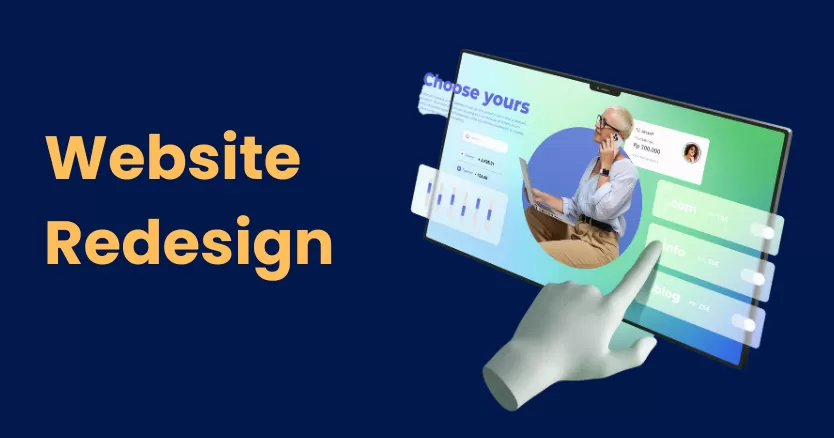
The Ultimate Guide to Website Redesign: Strategies and Design
Today, if your website is often the first point of contact between your business and potential customers. An outdated or poorly designed website can turn visitors away, but a well-executed redesign can boost your online presence and drive growth. In this blog, we will explore the essentials of website redesign, its strategies, and the principles of effective website design.
Why Consider a Website Redesign?
There are several reasons why you might consider redesigning your website:
- Outdated Design: Trends in web design change rapidly. A site that looked great five years ago might now appear dated.
- Poor User Experience (UX): If visitors find it hard to navigate your site, they won’t stick around.
- Mobile Responsiveness: With more people browsing on smartphones and tablets, your site needs to look good and function well on all devices.
- SEO Optimisation: A redesign can help improve your site’s search engine ranking.
- Brand Evolution: If your brand has evolved, your website should reflect the new direction.
Key Elements of a Successful Web Redesign

A website redesign is more than just a fresh coat of paint. Here are the essential elements to consider:
-
User Experience (UX)

User experience is all about how visitors interact with your site. Good UX ensures that visitors can find what they need quickly and easily. Key aspects include:
- Navigation: Your site’s menu should be intuitive, allowing users to find information with minimal effort.
- Loading Speed: Slow websites frustrate users. Aim for a loading time of three seconds or less.
- Mobile Optimization: Ensure your site looks good and functions well on mobile devices.
-
Content Strategy
Content is king. A successful redesign involves evaluating your current content and planning for new, engaging material. Consider:
- Relevance: Ensure your content is up-to-date and relevant to your audience.
- Quality: High-quality content that provides value to your users will keep them coming back.
- SEO: Use keywords strategically to improve your search engine rankings.
-
Visual Design

Visual design is the first thing visitors notice. A modern, clean design can make a strong first impression. Focus on:
- Consistency: Use a consistent color scheme, typography, and imagery throughout your site.
- White Space: Don’t clutter your site with too much information. White space helps guide the user’s eye and makes content more readable.
- Visual Hierarchy: Organise information so that the most important elements stand out.
-
Functionality
Your site needs to work well. Broken links, outdated plugins, and poor performance can frustrate users. Ensure:
- All Links Work: Regularly check for and fix broken links.
- Plugins and Tools are Updated: Keep your site’s software up-to-date for security and performance.
- Forms and Interactive Elements Function Properly: Test forms and interactive elements to ensure they work smoothly.
Developing a Redesign Strategy

A successful website redesign requires a clear strategy. Here’s a step-by-step guide to developing one:
-
Set Clear Goals
What do you want to achieve with your redesign? Common goals include:
- Improving User Experience: Make it easier for visitors to navigate your site.
- Increasing Conversions: Encourage more visitors to take desired actions, such as making a purchase or signing up for a newsletter.
- Boosting SEO: Improve your site’s visibility on search engines.
-
Analyse Your Current Site
Before making changes, understand what’s working and what’s not. Use tools like Google Analytics to gather data on:
- Visitor Behaviour: See which pages visitors spend the most time on and where they drop off.
- Traffic Sources: Understand where your traffic is coming from.
- Conversion Rates: Identify which pages are driving conversions.
-
Understand Your Audience
Your website should cater to your audience’s needs. Create user personas to represent different segments of your audience and understand their:
- Demographics: Age, gender, location, etc.
- Goals: What are they looking to achieve on your site?
- Pain Points: What challenges do they face?
-
Plan Your Content
Content is a crucial part of your website. Develop a content strategy that includes:
- Content Audit: Review existing content and decide what to keep, update, or remove.
- New Content: Plan for new content that aligns with your goals and audience needs.
- Content Calendar: Schedule when new content will be published.
-
Wireframing and Prototyping
Before jumping into design, create wireframes and prototypes. These are basic visual representations of your site’s layout and functionality. Tools like Sketch, Figma, or Adobe XD can help with this process.
-
Design and Development
Once your wireframes are approved, move on to the design and development phase. Work with designers to create a visually appealing layout and with developers to ensure the site functions properly.
-
Testing
Before launching your redesigned site, conduct thorough testing to catch any issues. Test for:
- Functionality: Ensure all features work as intended.
- Usability: Get feedback from real users to identify any usability issues.
- Responsiveness: Check how the site performs on different devices and screen sizes.
-
Launch and Monitor
After thorough testing, launch your redesigned site. Monitor its performance closely in the first few weeks to catch any issues early. Use tools like Google Analytics to track:
- User Behaviour: See how users interact with the new design.
- Traffic and Conversions: Measure changes in traffic and conversion rates.
- Feedback: Collect feedback from users to identify any areas for improvement.
Principles of Effective Website Design
Designing a website is both an art and a science. Here are some principles to guide you:
-
Simplicity
Keep your design simple and uncluttered. Focus on essential elements and avoid overwhelming users with too much information. Simplicity enhances usability and ensures visitors can find what they need quickly.
-
Consistency
Consistency in design creates a cohesive and professional look. Use the same color scheme, fonts, and design elements throughout your site. Consistency helps users navigate your site more easily.
-
Typography and Readability
Choose fonts that are easy to read. Use a clear hierarchy with different font sizes and weights to guide users’ attention. Ensure there is enough contrast between text and background to enhance readability.
-
Mobile Responsiveness
With a growing number of users browsing on mobile devices, your site must be mobile-friendly. Use responsive design techniques to ensure your site looks and functions well on all screen sizes.
-
Visual Hierarchy
Organize information in a way that highlights the most important elements. Use size, color, and positioning to create a visual hierarchy that guides users’ eyes to key information.
-
Engaging Visuals
Use high-quality images, videos, and graphics to make your site visually appealing. Engaging visuals can capture users’ attention and convey information quickly.
-
Accessibility
Ensure your site is accessible to all users, including those with disabilities. Use alt text for images, provide captions for videos, and ensure your site is navigable with a keyboard.
-
Fast Loading Times
Users expect websites to load quickly. Optimize images, use efficient code, and leverage caching to improve your site’s loading speed.
Conclusion
A website redesign is a significant undertaking, but it can have a profound impact on your business. By focusing on user experience, developing a clear strategy, and adhering to design principles, you can create a website that not only looks great but also delivers a seamless and enjoyable experience for your visitors.
Remember, a successful redesign is not just about aesthetics—it’s about improving functionality, enhancing usability, and ultimately driving your business goals forward.




